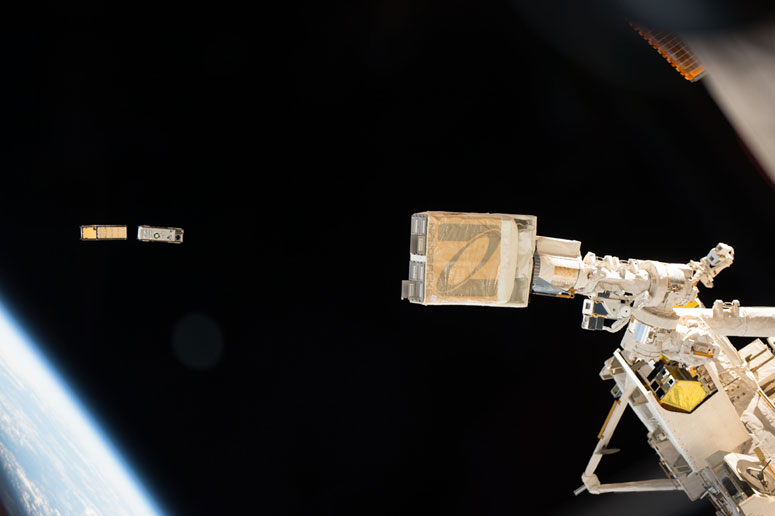IceCube CubeSat deployed from the International Space Station
IceCube CubeSat Deployed from the International Space Station
Philip Larkin, May 2017, philip.larkin@nasa.gov
![]()
IceCube, a three unit (3U) CubeSat funded by the In-space Validation of Earth Science Technologies (InVEST) program and the NASA CubeSat Integration Program (SCIP), was deployed from the International Space Station (ISS) on Tuesday, May 16. Official deployment time was at 11:54:59 GMT. Communication via the Wallops Flight Facility was established with the 10-pound, 3-unit CubeSat within hours of release, and all sub-systems reported nominal operations: both solar panels deployed, both antenna elements deployed, the battery showed full charge, and the system established safe hold mode.

The three-unit IceCube CubeSat (right CubeSat) is deployed from the Nanoracks deployer on the ISS (on the right). To the left of IceCube are two other CubeSats that deployed simultaneously: the one-unit Validation of a CubeSat Stellar Gyroscope System (SGSat) from the University of Kentucky and the two-unit Cosmic X-Ray Background Nanosatellite (CXBN-2) built by Morehead State University. (Image Credit: NASA)
As a freely-orbiting satellite, IceCube will demonstrate a new submillimeter wave radiometer technology and take, for the first time, global measurements of cloud ice at 883 GHz.
Global cloud ice properties are critical for quantifying the role of clouds in the Earth system, but they are challenging variables to measure accurately. Submillimeter wave remote sensing has the capability to penetrate clouds and measure ice mass and microphysical properties. The 883-GHz spectral window of IceCube’s radiometer is highly sensitive to ice cloud scattering and it interacts in depth with volume ice mass inside the cloud.
IceCube is configured to spin continuously around the axis to the Sun at ~1.2 degrees per second, allowing for maximum solar power reception and periodic Earth and space views for instrument calibration.
Once demonstrated, this submillimeter wave radiometer technology could directly benefit an ice cloud imaging radiometer, such as that called for by the Aerosol-Cloud-Ecosystem (ACE) mission concept. IceCube was launched to the ISS on April 18 from Cape Canaveral on Orbital ATK’s seventh contracted commercial resupply services mission (OA-7). The IceCube project team is led by principal investigator Dong Wu of the NASA Goddard Space Flight Center.
Below: A short NASA video feature on the IceCube release